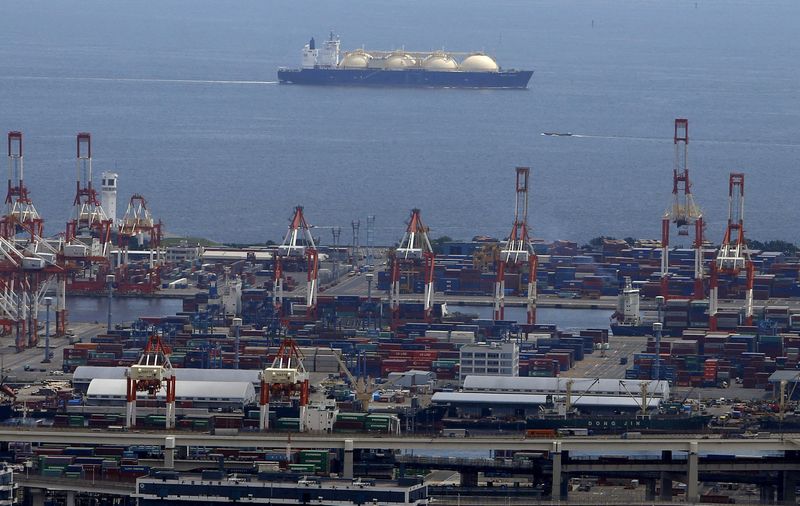TOKYO (Reuters) -Resource-poor Japan depends overwhelmingly on fossil-fuel imports to meet its energy needs, complicating calls for the nation to boycott Russia’s oil and liquefied natural gas (LNG) after Moscow’s invasion of Ukraine.
Here’s what’s at stake:
WHAT’S IN JAPAN’S ENERGY MIX, AND WHY IS LNG SO IMPORTANT?
Japan gets most of its primary energy needs from crude oil, more than 90% of which comes from the Middle East, based on government data. LNG comprises about 24% of the total energy mix.
But LNG takes up a bigger piece of the pie when it comes to electricity production, at 36%. That dependence has increased since 2011, when most of Japan’s nuclear facilities were idled after the massive earthquake and tsunami that triggered meltdowns at a plant in Fukushima, northern Japan.
HOW DOES JAPAN USE LNG AND WHERE DOES IT COME FROM?
Until it was overtaken by China last year, Japan was the world’s largest importer of LNG, accounting for about 22% of the total market, according to the U.S. Energy Information Administration. The LNG supply is primarily used in electricity production, but it is also used for heating and cooking in most residential households.
Australia was the biggest single supplier of LNG at 36% of Japan’s imports as of last year, followed by Malaysia with 14%. Russia accounts for 9%, the same as the United States.
COULD JAPAN REPLACE ITS RUSSIA-SOURCED LNG?
Given Russia accounts for less than 10% of Japan’s LNG supply, it could probably replace that supply from other sources. But that would only compound a surge in global prices, as demand for non-Russian gas grows while supply shrinks.
Asia LNG spot prices rocketed to a record of more than $59 per million British thermal units (mmBtu) recently, compared with less than $3 per mmBtu before the start of the COVID-19 pandemic.
Japan has more leeway with its crude oil supplies. The country’s top refiners have said they would be able to find replacements in the global spot market in the event of disruptions of Russian crude as it accounts for less than 4% of their total imports.
Japan also held 480 million barrels, or 240 days’ worth of oil reserves in national and private stockpiles as of December 2021. But there are only two-three weeks of LNG inventories because Japan does not have underground storage facilities, as is common in Europe, and long-term storage is not possible due to evaporation.
WHAT DO HIGHER LNG PRICES MEAN FOR THE ECONOMY AND THE BOJ?
The effect is already being felt in Japanese households in the form of surging power bills. The surging costs also add to inflationary pressures that have been compounded in Japan via supply chain disruption caused by the coronavirus pandemic.
So far, Bank of Japan Governor Haruhiko Kuroda has ruled out tightening monetary policy to deal with those pressures.
For Prime Minister Fumio Kishida, the increase in consumer energy prices could impact the government’s popularity ahead of critical Upper House elections this summer, according to Temple University political science professor James D.J. Brown.
WHAT JAPANESE FIRMS ARE INVESTED IN RUSSIAN LNG?
Trading houses Mitsui & Co and Mitsubishi Corp have stakes in the Sakhalin-2 project in eastern Russia. Mitsui also holds a stake in the $21 billion Arctic LNG 2 project, expected to be launched in 2023.
The Sakhalin Oil and Gas Development (SODECO), a consortium including Itochu Corp and Marubeni Corp, are part of the Sakhalin-1 project. In turn, the Japanese government itself has put billions of dollars into those projects in the form of loans.
CAN’T JAPAN JUST SWITCH ITS NUCLEAR REACTORS BACK ON?
Increasingly, Japan is doing just that. Power from nuclear plants slid to almost zero by 2014 in the wake of the Fukushima disaster, but now stands at about 3% of total energy production. The government wants to expand that to 20%-22% by 2030, though many market watchers believe that pace is infeasible.
Only six reactors are operating now, compared with 54 before the Fukushima disaster. Many others are still going through a re-licensing process under stricter safety standards.
Speeding up the nuclear restart could be Japan’s “best option” to make up for fuel shortages, senior lawmaker Itsunori Onodera told Reuters on Tuesday.
In perhaps another sign of this shift, the government said this week it would forgo an official memorial of the March 11 nuclear disaster for the first time since it occurred in 2011.
(Reporting by Rocky Swift and Yuka Obayashi; Editing by Kenneth Maxwell)




















